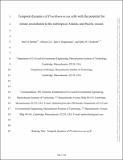Temporal dynamics of Prochlorococcus cells with the potential for nitrate assimilation in the subtropical Atlantic and Pacific oceans
Author(s)
Berube, Paul M.; Coe, Allison; Chisholm, Sallie (Penny); Roggensack, Sara
DownloadAuthorAcceptedManuscriptWatermarked.pdf (2.205Mb)
OPEN_ACCESS_POLICY
Open Access Policy
Creative Commons Attribution-Noncommercial-Share Alike
Terms of use
Metadata
Show full item recordAbstract
Utilization of nitrate as a nitrogen source is broadly conserved among marine phytoplankton, yet many strains of Prochlorococcus lack this trait. Among cultured strains, nitrate assimilation has only been observed within two clades of Prochlorococcus: the high-light adapted HLII clade and the low-light adapted LLI clade. To better understand the frequency and dynamics of nitrate assimilation potential among wild Prochlorococcus, we measured seasonal changes in the abundance of cells containing the nitrate reductase gene (narB) in the subtropical North Atlantic and North Pacific oceans. At the Atlantic station, the proportion of HLII cells containing narB varied with season, with the highest frequency observed in stratified waters during the late summer, when inorganic nitrogen concentrations were lowest. The Pacific station, with more persistent stratification and lower N : P ratios, supported a perennially stable subpopulation of HLII cells containing narB. Approximately 20–50% of HLII cells possessed narB under stratified conditions at both sites. Since HLII cells dominate the total Prochlorococcus population in both ecosystems, nitrate potentially supports a significant fraction of the Prochlorococcus biomass in these waters. The abundance of LLI cells containing narB was positively correlated with nitrite concentrations at the Atlantic station. These data suggest that Prochlorococcus may contribute to the formation of primary nitrite maxima through incomplete nitrate reduction and highlight the potential for interactions between Prochlorococcus and sympatric nitrifying microorganisms. Further examination of these relationships will help clarify the selection pressures shaping nitrate utilization potential in low-light and high-light adapted Prochlorococcus.
Date issued
2015-10Department
Massachusetts Institute of Technology. Department of Biology; Massachusetts Institute of Technology. Department of Civil and Environmental EngineeringJournal
Limnology and Oceanography
Publisher
American Society of Limnology and Oceanography, Inc.
Citation
Berube, Paul M., Allison Coe, Sara E. Roggensack, and Sallie W. Chisholm. “Temporal Dynamics of Prochlorococcus Cells with the Potential for Nitrate Assimilation in the Subtropical Atlantic and Pacific Oceans.” Limnology and Oceanography (October 2015): n/a–n/a.
Version: Author's final manuscript
ISSN
00243590
1939-5590